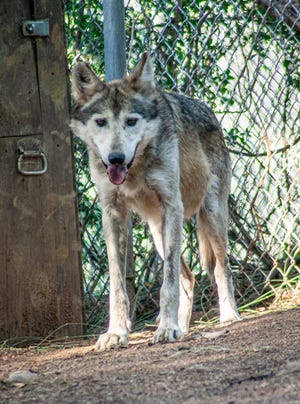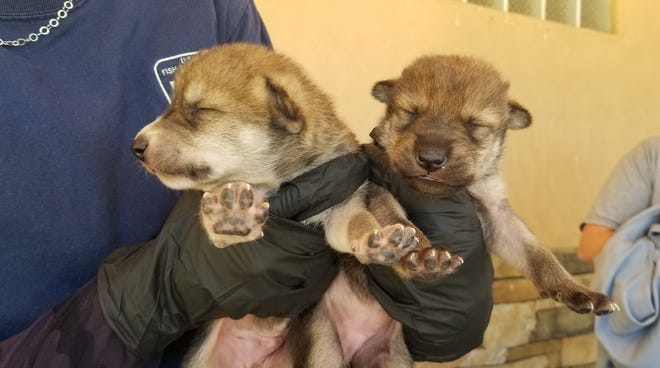[ad_1]
Federal wildlife managers have released 11 endangered Mexican wolf pups into the wild, injecting a much-needed genetic boost to an otherwise limited gene pool.
The effort is a part of the U.S. Fish and Wildlife Service’s cross-fostering program that mixes captive-born pups with wild ones as mother wolves give birth in the spring.
While the process of cross-fostering involves numerous agencies and detailed planning, the concept is straightforward. Captive-born wolf pups are removed from their natal dens and placed into surrogate, wild families.
But the on-the-ground work can still be tricky. Wildlife managers must remove the pups from their biological families, nurse them during transport, collect blood samples for further research and then put them into wild dens, sometimes with adult wolves still in them.
It’s done to help populations thrive. Genetic diversity is a significant measure of success for the Mexican wolf recovery program. Since there were only seven founding individuals, the species suffers from a dangerously low gene pool. According to some genetic research, each wild Mexican wolf is nearly as closely related as siblings.
The federal agency, along with state wildlife managers, has introduced cross-fostered pups into wild dens since 2014. Last year, teams released 22 captive pups into the wild. Because their population has been selectively bred, the pups bring higher genetic diversity.
Wildlife biologists say the future of both Mexican wolves and the recovery plans meant to save them rests on such injections of new blood. More genetic diversity means more resilience and adaptability in the face of a changing climate and environment.
“We all coordinated together to work towards a common goal, just like it has been in previous years,” said John Oakleaf, the Mexican wolf field projects coordinator for USFWS. “I think we do a tremendous job. One thing that was different this year from previous years was that all the cross fosters took place in a 15-day window. So it was a really tight window of work.”
Where the pups come from
Wolves are managed on the ground among state, federal and tribal partners, Oakleaf said. But zoos and conservation programs from across the country, including the Chicago Zoo and the Wolf Conservation Center in New York, helped with the breeding.
The pups were placed into five wild packs during a three-week period in the Mexican wolf experimental population area, inside a tightly enforced boundary south of Interstate 40 that stretches across the Apache-Sitgreaves National Forests in Arizona and the Gila National Forest in New Mexico.
The process begins during the summer when wildlife managers select captive breeding pairs based on the Mexican wolf species survival plan and software developed for species management, according to Maggie Howell, the executive director of the Wolf Conservation Center. The best pairs have low inbreeding coefficients.
What comes next is up to the wolves. The pairs are placed into enclosures together and if there’s chemistry, they’ll mate.
This is the second year the New York-based conservation center has participated in the program. It was able to provide one pup, a female named Crumbo, after Kim Crumbo, the conservationist who mysteriously disappeared in Yellowstone National Park last fall.
“He was just a huge proponent of rewilding and compassionate conservation,” Howell said. “A great ambassador that everyone can get behind and root for and just bring hope to the program itself and hopefully rewild our world, some hearts and minds.”
Closer to home, the Southwest Wildlife Conservation Center in Scottsdale provided two pups. Of the five partners, the center’s was the only litter to go to an Arizona pack.

The Southwest Center has been a part of the species’ survival program for years but most of its wolves are retired, too old to reproduce and too naive to be released into the wild. Jamie Haas, who is the marketing and education coordinator for the center, jokes that they are the Sun City East for Mexican gray wolves.
As a rescue and sanctuary, this is the first time the center has bred Mexican wolves. USFWS coordinated the matching of the parents-to-be. Melly and Moonlight, an older female and male, gave birth on April 30. The newborn pups were given about a week before they would be swapped into the wild litter.
Once wildlife managers are ready to relocate the pups, they send out another team to locate viable dens. Before releasing the adoptees-to-be, they took blood samples for genetic testing. This will allow them to identify the wolves as they mature.
At the den, the team sneaks the captive-born pups into the litter, mixing the scent of the wild pups in with the new littermates.
The pups’ eyes are still closed at that age, which reduces stress, but it’s also when the foster mothers are most likely to accept them, Oakleaf said. While the new recruits don’t go totally unnoticed, the mother’s maternal instincts kick in. For being so family oriented, the biological mothers also don’t seem too fazed by the process.
“They were a little stressed out for a few days, but I think up to five days later, it’s back to completely standard behavior,” Haas said. “They were both lying in their favorite spot, in the shade, on top of one of their wolf houses in their enclosure. So we are back to business as usual, which is really encouraging.”
Previous releases:20 Mexican gray wolf pups are placed into the wild
Why wolf pups are cross-fostered
Inbreeding has been a concern for wildlife biologists since the wolf recovery program began in 1998. While wild wolves generally avoid mating with direct family members, genetic diversity was limited from the beginning. It took careful planning to ensure that new mates are as genetically distinct as possible, something easily done in a captive environment, but less so in the wild.
The genetic rescue of Mexican wolves has been a marker of success for the program, but it was also an issue raised in a previous lawsuit. Conservation groups, including the Center for Biological Diversity, Earth Justice and Defenders of Wildlife, have advocated for years that wildlife agencies should do a better job of prioritizing genetic diversity.
Last year, the federal agency released a draft regulatory rule following a 2018 court order that ordered the agency to remedy several problems with the management rule, called the 10(j) experimental population rule.
To comply with the order, the agency has proposed adding a way to expand and measure genetic health. It’s essentially a captive-born release quota that biologists would like to see until 2030. This year, they would like to see at least nine pups survive to breeding age, a number that increases to 22 by 2030.
Species recovery:Federal agency outlines a plan to curb illegal killings of the Mexican gray wolf

Scientists say there are problems with the program
Independent scientists say there is a better way to measure genetic diversity. Mexican gray wolves are one of the most closely monitored wolf populations in the world. There are studbooks that would allow managers to identify the uniqueness of each wolf, so in theory, the wildlife agencies could release genetically distinct wolves into the wild. It’s used for other imperiled species like California condors and black-footed ferrets.
Another strategy, scientists say, could be expanding the area where wolves roam to allow for more natural exchange. The current area, while expanded in 2015, still isolates packs.
Some advocacy groups argue that there should be large areas that allow for natural genetic exchange. In the natural world, wolf populations from Mexico to Canada would have co-mingled and mixed, allowing for genetic exchange. That has been cut off by northern boundary of Interstate 40.
“I think if they expanded the area in which they release wolves, that would give them the opportunity to select genetically healthy individuals from the captive population,” said Carlos Caroll, a wolf biologist who served on the 2012 recovery team. “Actually releasing adult pairs with pups would give them a lot more scope to increase the diversity in the population.”
The fear, Oakleaf said, is that captive wolves would be more likely to run into conflict with people since they could be more habituated. The point of using wild wolves as surrogates should instill a wariness of people, he added.
Recovery area:Wildlife officials drew a line at I-40 for Mexican gray wolves but has it hurt recovery?
Genetically valuable wolves are being killed
Conservation advocates are also alarmed by the killing of genetically valuable adult wolves after claims of predation on cattle. Since the recovery program began, at least 100 wolves have been killed by federal officials at the behest of ranchers who claim the wolves prey on cattle. Last year, two wolves were illegally shot; one died, the other lost a leg to amputation.
But some of the killings are sanctioned by the government. A recent investigation into predation claims in New Mexico, led by the Western Watershed Project and the Intercept, alleged that many claims were bungled and that killing occurred without thorough investigations into whether wolves were actually killing the cattle. In some instances, federal officials approved of the killings with limited information.
The Tucson-based Center for Biological Diversity recently authored a letter that said cross-fostering offers little genetic rescue, the goal of the cross-fostering program.
There are now 196 Mexican wolves in the wild, a small increase from last year’s 186. So far, with the new additions, 83 cross-fostered puppies have been released in the wild, yet the survival rate has been low.
Of the 72 released as of last year, only 13 are known to be alive, and only four of them have reproduced. From those litters, only one of the descendants is known to be alive today.
Such small numbers are a stark reminder of how fragile the burgeoning population is and how valuable each additional pack member can be. While the recent news release said survival is greater than 50%, information provided to the Center for Biological Diversity says that it’s actually lower.
What this means for wolf conservation
Michael Robinson, who works on wolf issues for the Center for Biological Diversity, said to boost the odds for pups, the U.S. Fish and Wildlife Service should return to releasing well-bonded family packs consisting of an adult female and male together that have been together with their pups for at least six months.
“That was more successful than the fostering efforts,” Robinson said. “(Wildlife managers) ended the practice because it was successful. The livestock industry … demanded meetings with high-level officials and congressmen to oppose wolf recovery.”
For USFWS, managing the Mexican wolf program has been a delicate balance of fostering recovery without drawing the ire of influential livestock groups and politicians who oppose wolf recovery. Oakleaf said it’s more palatable for those who live with wolves to add pups to existing dens, where wolves already live, rather than putting them into new areas.
To help improve genetics and the overall population, cross-fostering appears to be the best the agency can do. While this year’s releases were half of last year’s, wildlife officials are touting it as a success. New babies added to the wild offer hope that there’s a future for the species and recovery.
“I think looking forward, we’ll continue cross-fosters and we’ll continue to kind of maximize our ability or the numbers that we can get out,” Oakleaf said. “We’ve seen some movement across the border so I’m hopeful that at some point, the two populations will be connected.”
Lindsey Botts is an environmental reporter for The Arizona Republic/azcentral. Follow his reporting on Twitter at @lkbotts and Lkbotts on Instagram. Tell him about stories at lindsey.botts@azcentral.com
Environmental coverage on azcentral.com and in The Arizona Republic is supported by a grant from the Nina Mason Pulliam Charitable Trust. Follow The Republic environmental reporting team at environment.azcentral.com and @azcenvironment on Facebook, Twitter and Instagram.
Support local journalism. Start your online subscription.
[ad_2]
Source link








/cloudfront-us-east-2.images.arcpublishing.com/reuters/BHLLQWCPDFJJTAFGOWMVCZQMZQ.jpg)



:quality(70)/cloudfront-us-east-1.images.arcpublishing.com/shawmedia/6G4CWFODPFCSHD5H3QJPUZZ6EI.jpg)








